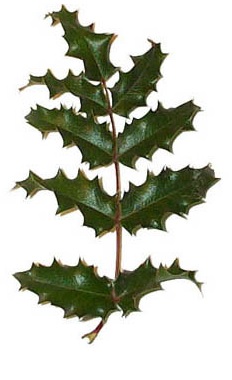 Oregon Grape and its Native Relatives - August 26, 2015 Jeff Schalau, Agent, Agriculture & Natural Resources University of Arizona Cooperative Extension, Yavapai County Oregon grape (Mahonia aquifolium) is a common landscape plant that somewhat resembles holly in its rich green color and spiny leaves. However, it is far more suitable for landscape use in the southwest than holly. Oregon grape has a few native relatives growing in the high plains, canyons, and mountains of north central Arizona. It is also resistant to wildlife herbivory and has moderate irrigation requirements making it worthy of consideration for your landscape. Oregon grape is an evergreen shrub growing from upright stems produced by a slow spreading rhizomatous root system. It's neither a grape nor a holly but a member of the barberry family (Berberidaceae). In protected spaces with irrigation, it can reach 5 to 6 feet in height. Oregon grape has compound leaves with 7 to 13 leaflets, each ringed with soft, spiny teeth. Most of the year leaves are dark green, but in winter they turn bronze to bright red and persist on the plant. It produces yellow flower clusters in spring which are followed by the formation of raisin-sized bluish fruit. Oregon grape is most effective in mass plantings where it can form a moderately dense hedge. In the Verde Valley, it will look its best in light shade or on a northern/eastern side of a structure or fence. Oregon grape should never be sheared. Rejuvenation pruning can be used to remove older, taller stems and promote new shoots at the base. I found an Oregon grape seedling growing in my vegetable garden a few years ago and transplanted it into another area of our landscape. It took off, and after five years with little care, it is four feet tall, two feet wide, and looking great. Oregon grape is native to the Pacific Northwest and was collected during the Lewis and Clark expedition. Neither Lewis or Clark were well trained in plant science, so prior to the expedition, President Jefferson sent Meriwether Lewis to Philadelphia for a crash course in botany from Dr. Benjamin Smith Barton. While there, Barton introduced him to Bernard M'Mahon, a Philadelphia nurseryman and friend of the president. Lewis learned how to properly collect and save seeds from M'Mahon, and following the expedition, seeds of many plants were successfully propagated. This included Oregon grape which M'Mahon sold through his catalog. If you haven’t guessed it yet, Mahonia was named after M'Mahon. The most popular Oregon grape cultivar is dwarf Oregon grape (Mahonia aquifolium ‘Compacta’) which resembles regular Oregon grape but is half as tall and quicker to spread by rhizomes. This is a good choice for smaller spaces where a mass of shiny, dark green foliage is desired. A local native, creeping Oregon grape (Mahonia repens), closely resembles M. aquifolium but has smaller leaves and wider leaflets. Creeping Oregon grape only grows to about 8 to 12 inches when grown with limited irrigation. It also spreads by rhizomes and makes an excellent shade-tolerant ground cover. It is found throughout the west including rocky canyons in local mountain areas. Fremont barberry (Mahonia fremontii), also called algerita, is a large drought-tolerant shrub common to the grasslands, chaparral, and pinyon/juniper woodlands of northern Arizona. It can reach a height of 10 feet and a width of 8 feet. The flowers and berries closely resemble those of Oregon grape. However, the foliage is blue green and the leaves are smaller and very spiny. Fremont barberry is commercially available and is very well-suited for privacy screening and use as a visual and tactile barrier. Red barberry (Mahonia haematocarpa) looks very similar to Fremont barberry, but is generally smaller in stature. While the flowers look similar to other Mahonia species, the ripe fruits are red rather than blue. It also has similar foliage in color and texture, but the terminal leaflet is distinctly longer than the other leaflets. The roots, stems, and berries of various Mahonia species have been used by Native Americans and modern day herbalists for a variety of treatments/ailments. Mahonia contains berberine (also found in goldenseal). The bluish berries are used to create a natural lavender dye and the bright yellow roots and inner bark are also used to create yellowish dye. Additional resources are included with the online edition (see URL below). Follow the Backyard Gardener on Twitter – use the link on the BYG website. If you have other gardening questions, call the Master Gardener help line in the Camp Verde office at 928-554-8992 or e-mail us at verdevalleymg@gmail.com and be sure to include your name, address and phone number. Find past Backyard Gardener columns or provide feedback at the Backyard Gardener web site: http://cals.arizona.edu/yavapai/anr/hort/byg/. Additional Resources Oregon Grape Washington State University Extension pnwplants.wsu.edu/PlantDisplay.aspx?PlantID=299 Small Shrubs for Small Spaces Colorado State University Extension www.colostate.edu/Dept/CoopExt/4dmg/Trees/Shrubs/smshrubs.htm Mahonia fremontii - Yavapai County Native and Naturalized Plants University of Arizona Cooperative Extension cals.arizona.edu/yavapaiplants/SpeciesDetail.php?genus=Mahonia&species=fremontii Mahonia haematocarpa - Yavapai County Native and Naturalized Plants University of Arizona Cooperative Extension cals.arizona.edu/yavapaiplants/SpeciesDetail.php?genus=Mahonia&species=haematocarpa |